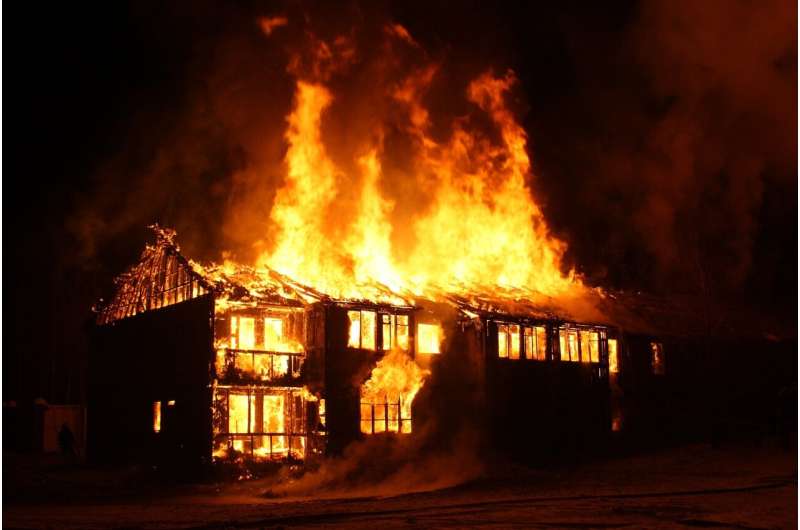This article has been reviewed according to Science X's editorial process and policies. Editors have highlighted the following attributes while ensuring the content's credibility:
fact-checked
peer-reviewed publication
trusted source
proofread
Experts demand fire safety policy change over health impact of widely used flame retardants

Leading environmental health experts have called for a comprehensive review of the UK's fire safety regulations, with a focus on the environmental and health risks of current chemical flame retardants.
The health dangers of substances meant to improve fire safety have prompted experts to demand a range of new measures to reduce risk.
Flame retardants are widely used to slow down or stop the spread of fire. They are used regularly in a range of products—from sofas and textiles to building materials. However, hundreds of studies have reported on the adverse effects of these chemicals, many of which are bioaccumulative and have been linked to wide-ranging health risks including cancer, developmental disorders, and DNA damage.
The UK has some of the highest use of flame retardants in the world and we are all being exposed in our daily lives. Retardants have been found in a range of places—including homes, schools, offices, and vehicles. They have been found in air and dust, in food and drinking water, and on indoor surfaces and textiles, where they can be absorbed through contact with the skin. The authors add this exposure is particularly noted in young children, who crawl around and pick up objects.
They are also found in natural environments, including rivers, lakes, oceans and sediments, as well as in fish, mammals and birds.
Such widespread use has in part been attributed to the flame ignition tests that are a primary focus of current fire safety regulations. Experts have questioned whether these tests are fit for purpose in reducing fire risk and believe the government's emphasis on these tests incentivizes the addition of large amounts of fire retardants to products.
The experts say there is also "significant uncertainty" about the extent flame retardants contribute to fire safety, and that there is evidence that flame retardants exacerbate smoke and fire toxicity.
Dr. Paul Whaley, from Lancaster University and a corresponding author of the statement, said, "There are longstanding concerns about the effectiveness of flame retardants and the health risks associated with them, which the UK Government has never adequately reconciled. This needs to change: There has to be a proper balancing of the harms and benefits of flame retardants that includes a comprehensive evaluation of the effectiveness of flame retardants as a fire safety measure, with serious attention paid to unintended harms of UK fire safety policy."
The evidence-based call to action, by a group of 13 experts, comes in the form of "A New Consensus on Reconciling Fire Safety with Environmental & Health Impacts of Chemical Flame Retardants," published February 28 in the journal Environment International.
The authors set out six measures for the Government to urgently take in a thorough review of the need for chemical flame retardants, including an end to incentivizing their use.
The authors instead call for incentivizing industry to develop "benign-by-design" furniture and materials that are inherently less flammable.
They also call for developing a labeling system to track retardants' use, allowing them to be identified and disposed of safely.
Also among their recommendations is the need to adopt a systemic approach to fire safety rather than a reductionist approach relying on ignition tests.
Professor Ruth Garside from the University of Exeter said, "The use of flame retardants is problematic at all stages of the lifecycle, potentially even exacerbating smoke and toxicity during the fires when they are supposed to provide a safety measure. With no clear labeling system, these substances are not disposed of correctly, which means they end up in recycled products.
"A significant proportion of fire deaths are caused by inhaling toxic fumes, so there's no time to delay in reviewing the fire safety regulations. We urge the government to take prompt action for the benefit of all our health."
UK Furnishing and Fire Regulations have been under review since 2014 but no revised policy has yet been formally proposed.
Professor Frank Kelly of Imperial College London, and co-author of the paper, said, "There is understandable concern surrounding the weakening of existing fire regulations, especially in the wake of tragedies such as the Grenfell Tower fire. However, it is vital that the use of these chemicals and their effectiveness in preventing fires is balanced with the serious long-term impacts on our health and environment."
Jamie Page of the Cancer Prevention & Education Society said, "Fire safety is a complex, multidisciplinary issue, but processes are largely dominated by industry. Well-reasoned challenges to current approaches need to be heeded. This will require more inclusive and transparent public consultation processes that will bring together views of different stakeholders."
More information: A New Consensus on Reconciling Fire Safety with Environmental & Health Impacts of Chemical Flame Retardants, Environment International (2023). DOI: 10.1016/j.envint.2023.107782
Journal information: Environment International
Provided by Lancaster University



















